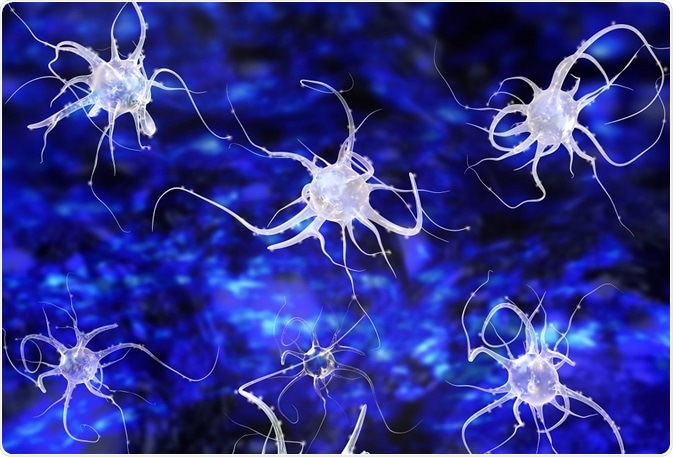One of the most fundamental ways in which we learn is through observation, followed by imitation. By studying macaque monkeys and observing certain regions in the human brain, scientists discovered a class of neurons responsible for learning, called mirror neurons.
 xrender | Shutterstock
xrender | Shutterstock
Ever since the discovery of mirror neurons, those central nervous system cells have been of great interest to neuroscientists, psychologists and neurology specialists alike.
Mirror neurons show activity both when an individual performs a particular action, as well as when they observe another person performing the same action. As such, they are thought to play a significant role in learning and intention understanding, speech and language evolution, emotional intelligence and empathy, and could be linked to certain neuropsychological disorders.
Neuron types in the human body
There are two types of neurons in the nervous system; motor neurons and sensory neurons. Motor neurons are associated with the execution of a certain action. They deliver signals from the brain to an effector, such as a muscle (cell) or a secretory gland.
In contrast, sensory neurons deliver signals from a receptor, such as pain or temperature receptors in the skin to the appropriate regions in the central nervous system. While every organ in our body is supplied by both motor and sensory neurons, they are functionally different.
Mirror neurons, however, were originally described as nervous system cells which “discharged both during monkey’s active movements and when the monkey observed meaningful hand movements made by the experimenter”. This means that they show activity both when an action is being observed (the sensory component) and when the same action is being executed (the motor component).
The mirror neuron system
The results of human neuroimaging experiments provide strong evidence that the same mirror neuron system that was originally discovered in the macaque monkey’s premotor cortex, in the area F5, is also present in human brains.
In one study, the brain activity of 21 participants was recorded while they were asked to either observe or perform a certain action themselves (either hand grasping or a particular facial expression). As a result, a number of neurons was been shown to be stimulated by both action observation and execution.
Further studies have shown that this particular class of neurons starts developing before the age of 12 months and is linked to early human development and the ability of infants to learn by imitation.
The significance of mirror neurons
In 2000, a known neuroscientist and author Vilayanur Ramachandran said that “mirror neurons will do for psychology what DNA did for biology”. While the hype has died down a little since, neuroscientists are still excited about the clinical significance of the mirror neuron system.
The idea is that thanks to mirror neurons, we are able to first observe an action (“What is being done?”), then understand the intention of that action (“Why is it happening?”) and finally, to reproduce the same action in order to achieve similar results (the motor component).
Both our understanding of an action and the ability to then mirror that same action is of great significance to learning, speech perception, and emotional intelligence. One argument is that since mirror neurons are responsible for both the “what” and the “what for” of a particular action, they are strongly linked to our ability to show empathy.
If we see a person crying, we must be able to identify the action and then positively correlate it with the feeling of sorrow. The mirror neuron system also teaches children to cry to show their discontent.
Similar arguments had been made in favor of the mirror neurons’ role in language learning and, in fact, in the way that our civilization had evolved over centuries.
mirror neurons
Approaching mirror neurons with caution
However, caution must be taken when trying to show a direct link between the mirror neuron system and certain neuropsychological disorders. This particularly applies to autism.
Firstly, both the original studies performed on macaque monkeys and the subsequent studies on human brain function have a number of limitations.
In fact, there is still an ongoing discussion on whether those mirror neurons discovered in the primates’ brains are the same ones that we observe being activated in the fMRI studies performed on humans.
Secondly, no conclusive evidence had been given in favor of the argument that patients who suffer from autism always show a decrease in the function of those areas of the brain associated with mirror neurons.
Overall, mirror neurons are a fascinating component of the human body that will no doubt be studied further in the years to come, providing promising evidence in understanding the human brain and our ability to learn.
Sources
- Rizzolatti G, Craighero L. The Mirror-Neuron System. Annu Rev Neurosci. 2004;27:169–92.
- Acharya S, Shukla S. Mirror neurons: Enigma of the metaphysical modular brain. Journal of Natural Science, Biology, and Medicine. 2012;3(2):118-124. DOI:10.4103/0976-9668.101878.
- Kilner JM, Lemon RN. What We Know Currently about Mirror Neurons. Current Biology. 2013;23(23):R1057-R1062. DOI:10.1016/j.cub.2013.10.051.
- Lingnau A, Caramazza A. The origin and function of mirror neurons: the missing link. Behav Brain Sci. 2014 Apr;37(2):209-10. DOI:10.1017/S0140525X13002380.
- Mukamel R, Ekstrom AD, Kaplan J, Iacoboni M, Fried I. Single-neuron responses in humans during execution and observation of actions. Curr Biol. 2010 Apr 27;20(8):750-6. DOI:10.1016/j.cub.2010.02.045. Epub 2010 Apr 8.
Further Reading